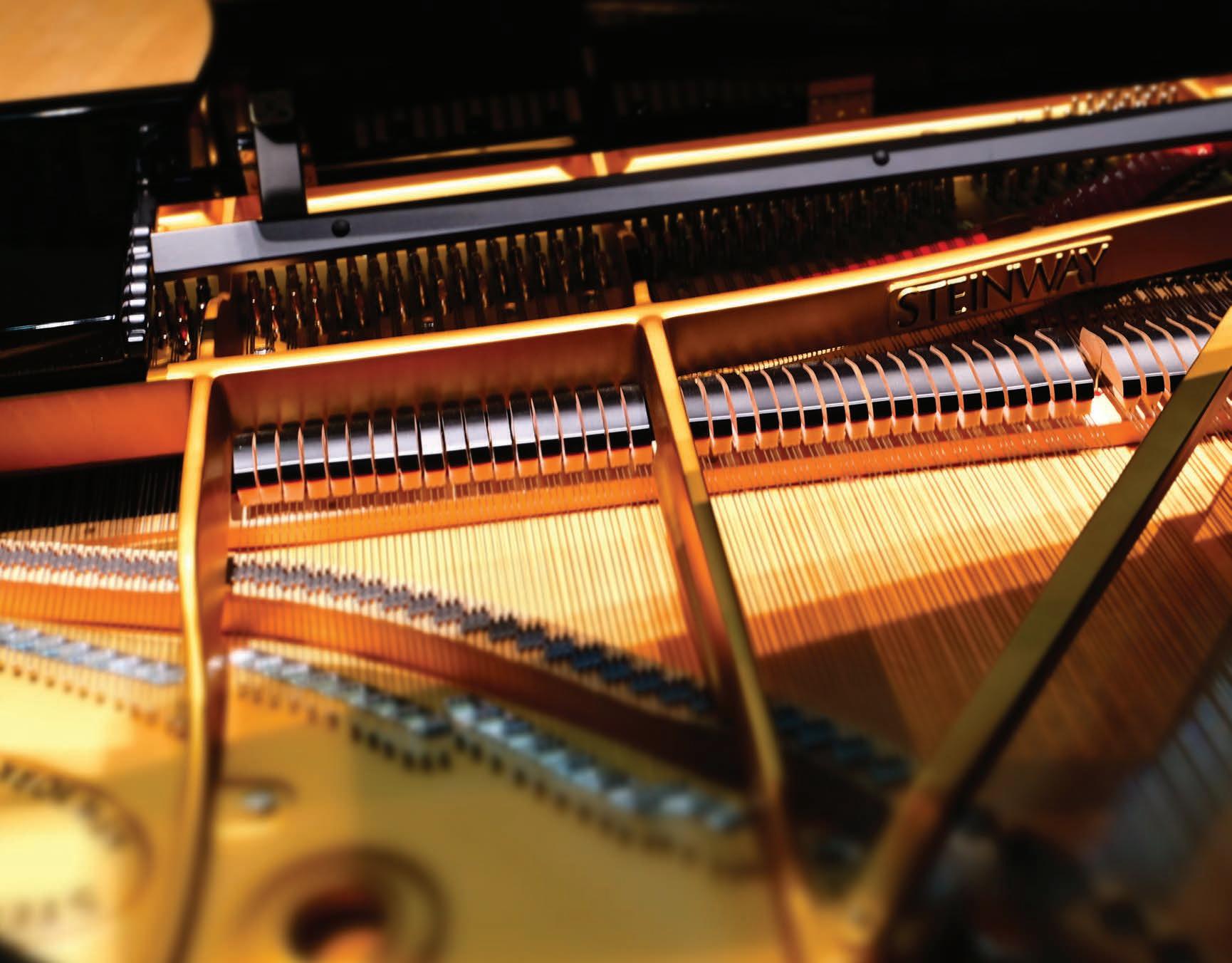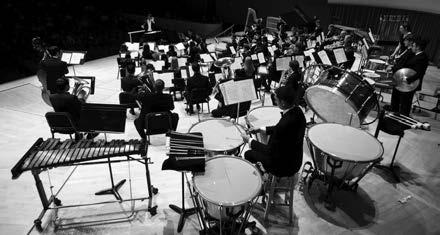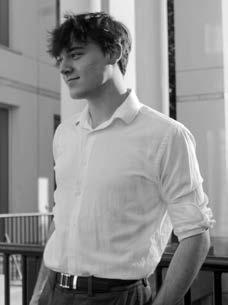MUSIC AT EMORY

2022–2023
This concert is presented by the Schwartz Center for Performing Arts.
404.727.5050 | schwartz.emory.edu | boxoffice@emory.edu
Audience Information
Please turn off phones and all electronic devices. Photography, recording, or digital capture of this concert is not permitted.
Health and Safety
The Schwartz Center follows the Emory University Visitor Policy with additional protocols outlined at schwartz.emory.edu/faq.
Ushers
The Schwartz Center welcomes a volunteer usher corps of approximately 60 members each year. Visit schwartz.emory.edu/volunteer or call 404.727.6640 for ushering opportunities.
Accessibility
The Schwartz Center is committed to providing performances and facilities accessible to all. Please direct accommodation requests to the Schwartz Center Box Office at 404.727.5050, or by email at boxoffice@emory.edu.
Design and Photography Credits
Cover Design: Lisa Baron | Cover Photo: Mark Teague
Acknowledgment
This season, the Schwartz Center is celebrating 20 years of world-class performances and wishes to gratefully acknowledge the generous ongoing support of Donna and Marvin Schwartz.
MUSIC AT EMORY
Solo Journey
Emory Wind Ensemble

Eli Parrish, student composer
Lucky Bao, student composer
Brianna Slone, conductor
Will Pitts, guest conductor
Sunday, February 26, 2023, 4:00 p.m.
Emerson Concert Hall
Schwartz Center for Performing Arts
2022–2023
Program
Fanfare for an Introvert Eli Parrish (b. 2001)
Eli Parrish, student composer
Solo Journey
Lucky Bao, student composer
Tianqi (Luck y) Bao (b. 2001)
Bull’s-Eye
Viet Cuong (b. 1990)
Gum-Suckers March Percy Grainger (1882–1961) arr. Rogers
Will Pitts, guest conductor
eos
Will Pitts, guest conductor
La Procession du Rocio, op. 9
Will Pitts (b. 1986)
Joaquin Turina (1882–1949) arr. Reed
4
Program Notes
Fanfare for an Introvert (2022)
Fanfare for an Introvert explores ethereal and psychedelic textures and harmonies. The piece’s inspiration draws from a piece of AI-generated art.
—Program note by composer
Solo Journey (2023)
This is a piece composed in remembrance of a period of time when the composer had undergone some mental stress. Though the composer went on a real “solo journey” later, the “journey” for this piece means both the one in reality and the one in one’s heart. Along with trying to portray the gorgeous scenery the composer saw during her trip, she also wants to depict the beauty of life experiences, her determination to face the frustration, and the will to keep going forward with a light heart. This piece is inspired by the music of Russian composer Igor Stravinsky and Japanese film composer Joe Hisaishi.
—Program note by composer
Gum-Suckers March (1914/1996)
A “gum-sucker” is an Australian nickname for Australians born in Victoria, the home state of the composer. The eucalyptus trees that abound in Victoria are called “gums,” and the young shoots at the bottom of the trunk are called “suckers;” so “gum-sucker” came to mean a young native son of Victoria, just as Ohioans are nicknamed “Buckeyes” (buckeyes are also trees prevalent in Ohio). In the march, Percy Grainger used his own Australian Up-Country Tune melody—written by him to typify Australia—a melody he also employed in his Colonial Song for two voices and orchestra, or military band.
—Program note by composer
Bull’s-Eye (2019)
I’ve always been intrigued by Pablo Picasso’s line drawings, where he captures the energy and personality of a subject—often an animal—with just a line or two. Picasso’s Bull (1945) includes a simple line drawing of a bull in this fashion. However, this drawing is also preceded by a series of 10 lithographs depicting his process of simplification and abstraction. The first lithograph is a fully formed bull that, over its next two iterations, increases in opacity and detail. Then, over the next eight panels, layers are gradually peeled away to reveal just the essence of the bull.
5
While Bull’s-Eye is not an exact one-to-one depiction of these 11 drawings, the piece follows the same narrative: musical material is presented, made more complex, then distilled. The distillation process in the second half of the piece reveals the way the music preceding it is orchestrated, almost as if you were to mute and unmute certain sections of the ensemble.
—Program note by composer
eos (2008)
One of my favorite parts of my parents’ house in western Georgia is its exposure to the sunrise. Every morning, light slowly appears over the lake behind our house, yielding a progression of vibrant colors and increasing brightness that is difficult to describe. eos was actually named about halfway through my writing of the piece. As I listened to these chords and the subtle harmonic progressions, I associated these aural ideas with the visions in my head of the sunrises at home. In Greek mythology, Eos is the goddess of dawn who rises from her home at the edge of Oceanus to pave the way for her brother Helios, the sun. The piece is not necessarily programmatic, but after listening to what I had put down on paper, I could not help but feel as though the music flowed just as the dawn. eos is dedicated with humble admiration and unending appreciation to Scott A. Stewart, a great mentor, an incredible conductor, my greatest teacher, and a selfless friend. If it were not for him, I would probably still be in business school . . .
—Program note by composer
La Procession du Rocio, op. 9 (1912)
La Procession du Rocio, op. 9, “The Procession of the Dew,” was the work that catapulted Joaquin Turina to success. Its debut performance in Madrid in 1913 was received so well that he decided to return to Spain, where he rose to the top of the Spanish musical world, eventually becoming professor of composition at the Madrid Royal Conservatory.
La Procession is divided into two distinct sections. It opens with a depiction of the celebration honoring the Virgin Maria in Triana (a colorful neighborhood in Seville), which features stylized gypsy dances and a general mood of festivity. This leads, without break, into the procession itself. Here the character of the music changes. As the procession moves slowly through the streets, the sound of bells, the tap of drums, and strains of church music reflect the solemnity of its religious origin. Finally, the music grows to a brilliant climax, including themes derived from the opening fanfare, along with a brief quotation from the Spanish national anthem.
—Program note by Immaculata Symphony
6
Student Composer and Guest Conductor Biographies
Eli Parrish began his compositional career with a niche for wind instruments and symphonic bands. Parrish’s music has been performed at universities, high schools, festivals, and venues across the Southeastern United States. His works for chamber groups, solo instruments, and large ensembles explore the intersections of storytelling, environmentalism, and sound-to-color. Parrish’s approach to orchestration, use of dissonance, and texture stems from his background of studying and performing wind ensemble repertoire. Parrish frequently collaborates with other young composers in the Emory composition studio to curate showcases and workshops for new music.

Tianqi (Lucky) Bao is a senior student studying music composition and quantitative science at Emory University. She is interested in film scoring, music production, live band music, and other branches of music. Her music has been influenced by film composers including Joe Hisaishi, Tan Dun, and Hans Zimmer; and pop singers including Liang Bo and Hua Chenyu. As a person who does not speak much in daily life, Bao turns to illustrate her expression in music, seeking a spiritual connection between her inner world and the outside world. By taking music as a path, she tries to show her own vision and insight to the audiences.

7
William Pitts is a composer, conductor, and arranger from Atlanta. Pitts graduated summa cum laude from Emory, where he studied saxophone, conducting, and composition. He has completed graduate study in music at North Georgia University and the University of Michigan. Pitts has written works for and been commissioned by the Boston Pops, the University of North Texas, the Canadian Staff Band of the Salvation Army, Wake Forest University, the Atlanta Youth Wind Symphony, the Atlanta Trumpet Ensemble, the Vega Quartet, the Atlanta Saxophone Quartet, the Northwinds Symphonic Band, french hornist J.D. Shaw, tubist Christian Carichner, and numerous other high school and collegiate wind and chamber ensembles.
Pitts most recently served as the brass arranger for the Phantom Regiment Drum and Bugle Corps of Rockford, Illinois. As a member of the corps, Pitts served as conductor for three years (2005, 2007–2008), and in 2008 he was honored as the Mark Glasscoe Member of the Year. In addition to his role as arranger, he has served on Regiment’s management staff, and as the brass arranger and composer for the Spirit of Atlanta Drum and Bugle Corps.
As a music educator, Pitts has served on the faculties of Duncanville High School (Duncanville, Texas) and Pace Academy in Atlanta, and he currently serves on the faculty of the Westminster Schools in Atlanta, specializing in instrumental music, conducting, and music theory.

Emory Wind Ensemble
The Emory Wind Ensemble (EWE) is dedicated to performing wind band and chamber literature of the highest caliber while nurturing individual artistic excellence within an ensemble setting.
Concert programming comprises a wide variety of styles, forms, and genres from several centuries of compositional practice, designed to provide a comprehensive exposure to the masterpieces for winds and percussion from the Renaissance period through the modern era.
The EWE performs two concerts each semester, regularly participates in world premieres of new music, tours the United States and abroad, and is a national leader in the commissioning of new music, including works by Warren Benson, Bruce Broughton, Jennifer Higdon, Libby Larsen,
8
John Mackey, Jonathan Newman, Joseph Schwantner, and many others. The EWE’s recent collaborations include performances with the Emory University Chorus; the Emory Dance Company; Emory’s Mary Emerson Professor of Piano William Ransom; Chris Martin, principal trumpet of the Chicago Symphony Orchestra; Stuart Stephenson, principal trumpet of the Atlanta Symphony Orchestra; Joe Alessi, principal trombone of the New York Philharmonic; Adam Frey, international euphonium solo artist; and Grammy Award–winning solo clarinetist Richard Stoltzman, among many others.
The EWE has performed concert tours of Munich, Salzburg, Innsbruck, Lucerne, Graz, Prague, Vienna, and Greece. Additionally, the EWE has performed at the Georgia Music Educators Association (GMEA) State Convention in Savannah, Georgia; the Southern Division College Band Directors National Association Conference (CBDNA); and for various events on the Emory campus, including the inauguration of James Wagner as president of Emory University. The EWE was recognized in 2017 as a Top 10 program among its peers by CBDNA and featured at the 2017 CBDNA National Conference Small Band Showcase. The EWE is recorded on the NAXOS music label.
Brianna Slone (she/her) serves as the conductor of the Emory University Wind Ensemble and upper school faculty at the Westminster Schools. Previously, she was the assistant band director at Hillgrove High School in Cobb County, Georgia, and a music library assistant with the Atlanta Symphony Orchestra.
Slone is a sought-after guest conductor, clinician, woodwind specialist, and freelance flutist in the Atlanta area. She was recently appointed as a Music for All Band Clinician and in this capacity was selected as an instructor for the 2022 Music for All Tournament of Roses Honor Band. She has attended flute master classes with Marianne Gedigian, Ransom Wilson, Nicole Esposito, Michael Hasel, and Emmanuel Pahud.
Slone has a bachelor of music education degree from the University of Georgia and a master of music degree in wind band conducting from Georgia State University.

9
Flute/Piccolo
Emily Cui
Dorian Huang
Hannah Huang
Tabitha Watson
Oboe
Zachary Kant
Sophia Kim
English Horn
Eric Xu
Bassoon
Vishaal Kareti
Nathan Muz
Clarinet
Nicole Bring
Joe Van Duyn
Eli Parrish
Deston Lian
Karthik Valeveti
Emory Wind Ensemble
Alto Saxophone
Rishie Srivastava
Paulark Yan
Katherine Wang
Tenor Saxophone
Dan Dan
Bari Saxophone
Wenhui Lu
Horn
Kayla Beck
Tess Enmark
Amelia Young
Trumpet
Joey Chen
Natalie Park
Joseph Rosenbaum
Trombone
Timothy Brewer
Christopher Park
Josh Peacock
Shiven Sinha
Euphonium
Allen Zhang
Kerry Zhu
Tuba
Michael Amsel
Double Bass
Alex Petralia
Percussion
Kaylor Garamella
James Grant
Alexa Mohsenzadeh
Peter Rubin
Emmy Shi
Harp
Brigid May
Piano
Dorian Huang
Sonny Yoo
10
Upcoming Emory Music Concerts
Many spring music events at Emory are free to attend. Visit music.emory. edu or schwartz.emory.edu to view descriptions and information for upcoming music events. If an event requires a ticket for attendance, prices are indicated in the listings below in the following order: Full price/Emory student price (unless otherwise noted as the price for all students).
Thursday, March 2, 8:00 p.m., West-Eastern Divan Ensemble with Michael Barenboim, Candler Concert Series, Schwartz Center, Emerson Concert Hall, $50/$10, tickets required
Saturday, March 4, 8:00 p.m., Elena Cholakova, piano, and Anyango Yarbo Davenport, violin, Schwartz Artist-in-Residence Program, Schwartz Center, Emerson Concert Hall, free
Friday, March 10, and Saturday, March 11, 8:00 p.m., Magnificat: Bach, Byrd, Rachmaninoff, Stanford, Howells, and Pärt, Atlanta Master Chorale, Schwartz Center, Emerson Concert Hall, $38/$10 all students, tickets required
Friday, March 17, 8:00 p.m., Lawrence Brownlee, tenor: Rising, Schwartz Artist-in-Residence Program, Schwartz Center, Emerson Concert Hall, $50/$10, tickets required
Saturday, March 18, 2:00 p.m., Athena Grasso, Junior Piano Recital, Schwartz Center, Emerson Concert Hall, free
Saturday, March 18, 5:00 p.m., Vivian Zhao, Junior Piano Recital, Schwartz Center, Emerson Concert Hall, free
Sunday, March 19, 2:00 p.m., Thomas Sarsfield, Senior Violin Recital, Schwartz Center, Emerson Concert Hall, free
Sunday, March 19, 4:00 p.m., Atlanta’s Young Artists, ECMSA: Family Series, Carlos Museum, free
Sunday, March 19, 5:00 p.m., Eric Zhang, Senior Piano/Violin Recital, Schwartz Center, Emerson Concert Hall, free
Friday, March 24, noon, Bernadene Blaha, piano, ECMSA: Cooke Noontime Concert, Carlos Museum, free online registration required
11
Music at Emory
Music at Emory brings together students, faculty, and world-class artists to create an exciting and innovative season of performances, lectures, workshops, and master classes. With more than 150 events each year across multiple Emory venues, audiences experience a wide variety of musical offerings.
We hope you enjoy sampling an assortment of work from our student ensembles, community youth ensembles, artists in residence, professional faculty, up-and-coming prodigies, and virtuosos from around the world.

404.727.5050
music.emory.edu







